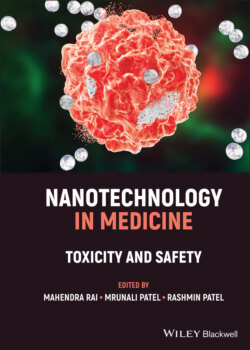Читать книгу Nanotechnology in Medicine - Группа авторов - Страница 19
На сайте Литреса книга снята с продажи.
1.3.3 Tissue Engineering and Regenerative Medicine
ОглавлениеNanomaterials of low toxicity, contrasting agent properties, customizable characteristics, targeted/stimuli distribution ability, and accurate behavioral regulation via external stimulus are valuable tools for achieving unparalleled efficiency in driving and overcoming barriers in tissue engineering. The extraordinary mechanical strength and electrochemical properties of carbon nanostructures corresponding to graphene, carbon nanohorns, fullerenes, nanodiamonds, single/multi‐walled carbon nanotubes; the fluorescence properties of quantum dots; the antimicrobial effect of silver and other metal/metal oxide NPs; and surface conjugation as well as surface conductive properties of gold NPs have made them quite successful in different tissue engineering and regenerative medicine applications (Makvandi et al. 2020) as seen in Figure 1.2.
These residing nanomaterials must unveil biocompatibility, boost the growth of cells, promote the proliferation of various types of cells, provide regulated means for delivery of bioactive and contrast agents to manage and track the engineered tissues. Furthermore, nanodiamond–polymer composites are also seen as a promising medium for repairing damaged tissues due to their unique mechanical properties, fluorescence capability, and biocompatibility (Hasan et al. 2018). The emerging field of nanoneedles for intracellular distribution, intracellular pH estimation, probing, and cell‐interfacing is currently growing promptly and displays abundant potential. Nanotechnology proposes innovative culture approaches to resolve the prevalent problem of cell‐based therapy with minimal retention in target tissues. It has got the ability to generate smart surfaces that renders intermittent adhesive properties to cells. This makes detachment of cell patches from cell culture substrate feasible for further transplantation (Kubinova and Sykova 2010). Cell sheet patch therapies have paved the way for possible cell and tissue engineering therapies for patients suffering from various disorders such as cardiomyopathy, osteoarthritis, and periodontal reconstruction. Nanomedicine is now emerging as a powerful tool to mitigate organ donor shortages. The formation of in vitro whole organs is a present‐day requirement in the field of biomedicine. This is fulfilled by nanomaterials enabling the production of artificial organs for regenerative medicine as well as organs‐on‐a‐chip applications.
Figure 1.2 Nanomaterial applications in tissue engineering and regenerative medicine.
Source: Based on Makvandi et al. (2020).
